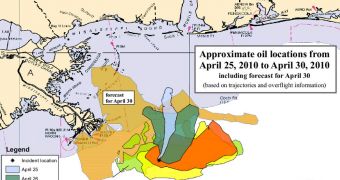Exactly ten days ago, the Deepwater Horizon oil rig exploded in the Gulf of Mexico, off the coast of Louisiana. 48 hours later, on April 22, it sank, and triggered a large oil spill, which became apparent a couple of days later. Since then, the size of the oil slick has increased constantly, as authorities attempted to reduce the amount of oil that is being spilled into the Gulf every day. Yesterday, officials at the US Coast Guard announced that the scale of the devastation might be five times larger than originally thought, the BBC News reports.
The US officials said that as much as 5,000 barrels (210,000 gallons) of crude may be spilling into the water every day, rather than the 1,000 barrels specialists initially estimated. Rear Admiral Mary Landry, who is in charge of the clean-up and containment efforts, said that the oil slick, which began forming some 50 miles (80 kilometers) away from the extremely sensitive coasts of Louisiana is currently slowly but surely making its way to the shorelines. If the oil reaches these areas, then environmentalists will have a major natural disaster on their hands. The swamps here are the spawning grounds for countless fish and bird species, and contain numerous natural reserves.
Landry announced that a third leak had been discovered at the site of the Deepwater Horizon incident, which is why the initial estimates were upped. “Probably the only thing comparable to this [incident] is the Kuwait fires [following the Gulf War in 1991]. The Exxon Valdez [tanker disaster off Alaska in 1989] is going to pale [into insignificance] in comparison to this as it goes on,” told the BBC World Service the head of Safety Boss, Mike Miller. The company is based in Canada, and it is specialized in oil well fire-fighting. During the Exxon Valdez spill, some 11 million gallons of oil were spilled in delicate Arctic waters over a period of two months.
Two days ago, expert firefighters set fire to a portion of the oil slick. They hoped that the controlled burn would stop the spread of the crude into sensitive areas of the coast. The stakes of the game have just been increased today, as the slick moved terribly close to the Mississippi Delta, a remarkable area that could suffer extensive damage from oil contamination. Burning the crude is not a solution, authorities warn, saying that the leaks themselves need to be sealed as soon as possible. Unfortunately, weather forecasts show that prevailing winds will drive the oil to shore by Friday night or early Saturday morning.

 14 DAY TRIAL //
14 DAY TRIAL //